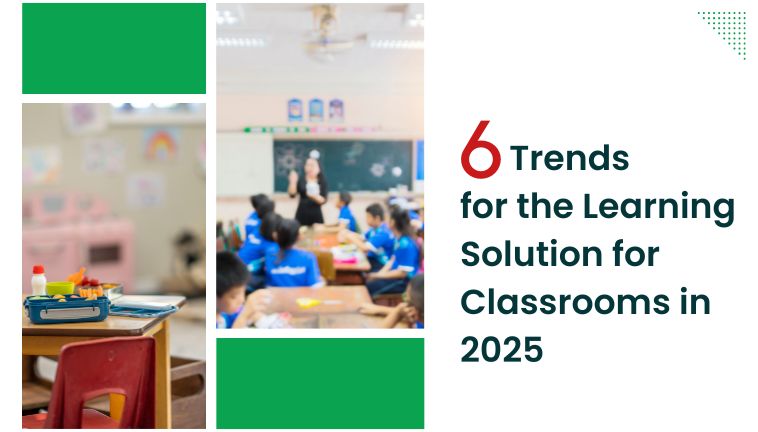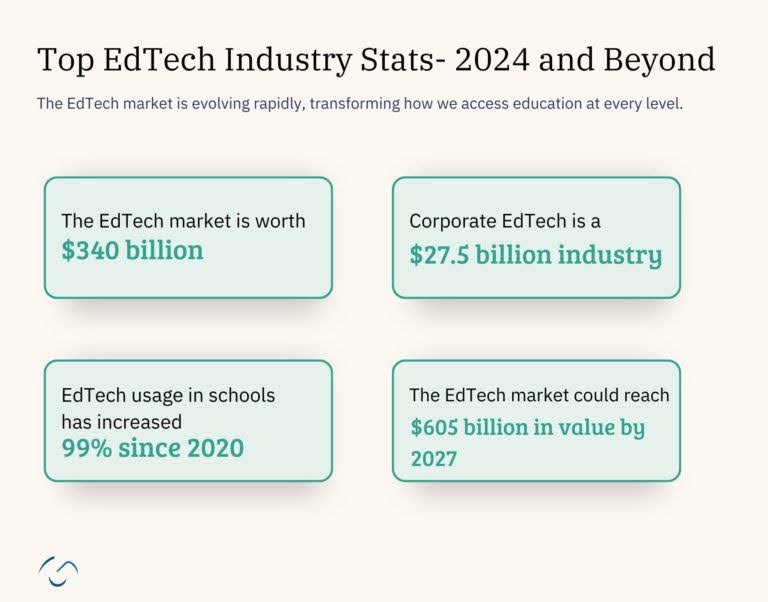Blogs
6 Trends for the Learning Solution for Classrooms in 2025

Education is a right that belongs to everyone. To make it more accessible and effective, Edtech and educational institutions are moving away from traditional methods, adopting modern solutions powered by the latest technology. Today, 85% of teachers favor digital tools as a better learning solution for classrooms.
Technology use in K-12 schools has increased by 99% in recent years. Many edtech companies are now setting standards for delivering personalized education to all students.
The EdTech market is changing fast, reshaping how we access education at all levels. To launch your EdTech business in this competitive space, staying updated on the top education trends for 2024 and beyond is essential.
Major Stats for Edtech for 2024 & Beyond
The EdTech market is changing fast, reshaping how we learn at all levels.

Credits: Ongraph
- The EdTech market received over $20 billion in investments, making it one of the fastest-growing industries.
- Digital learning solutions for classrooms are now the leading strategy for corporate skill-building.
- By 2028, AI in education is projected to see an additional $21 billion in investment.
- E-learning reduces the carbon footprint by 85% per student and saves 90% of energy.
- Since the pandemic, 87% of K-12 teachers have enhanced their skills.
- Currently, 72% of organizations use a learning management system.
Major Trends for Learning Solution for Classrooms
Here are some trends shaping the future of education:
1. Collaborative Learning
Education’s future is all about teamwork. In collaborative learning, students work in small groups on challenging tasks, guided by a teacher.
While solo work helps students grasp the material, teamwork builds resilience and boosts confidence. In this method, students actively participate instead of just listening to lectures. They create, explore, and reshape knowledge together. With digital learning solutions for classrooms like Geneo, learning becomes something students do rather than something done to them, empowering them to draw their own conclusions.
2. Artificial Intelligence for Personalized Learning
AI is a leading trend in educational technology, with 60% of teachers now using it in smart classrooms. This tech has become a game-changer, offering tailored learning experiences for students and support for teachers. Tools like ChatGPT are helping educators create better content and engage students. So, how is AI used in education?
- Personalized Learning - AI lets teachers adjust lessons, sessions, and materials to suit each student’s needs. This helps students access relevant study resources for more effective learning.
- Automation - AI speeds up grading and simplifies scheduling, saving teachers time and enhancing the quality of instruction.
- Interactive Teaching Materials - AI can make learning more engaging. Flow-based diagrams and interactive content make complex topics easier to grasp.
- Content Generation - Gone are the days of manually creating graphics and content. AI quickly gathers information and generates visuals to improve comprehension.
- Adaptive Learning - AI-driven adaptive learning tools customize activities to suit each student’s style, helping them learn in ways that align with their interests and abilities.
3. Big Data and Analytics
Over the last decade, knowledge retention has increased from 25% to 60%, thanks to advanced systems that analyze student data to enhance teaching methods.
A major trend in education, "datafication" involves converting various learning elements into measurable data. This data is then used for learning analytics, which can predict student performance and customize their learning experience.
How Can Data Analytics Benefit Education?
- Tracking Student Performance - Schools can use learning solutions for classrooms as a tool to monitor student progress and identify areas for improvement. For example, if a high school sees a drop in math scores, they can analyze the data to understand why and make adjustments.
- Optimizing the Curriculum - Big data reveals which teaching methods work best and highlights subjects needing more focus. This helps educators refine course content and teaching strategies.
- Early Warning Systems - Data analytics can identify students who may need extra help. For instance, it can flag students with low attendance, allowing schools to intervene early.
4. Blockchain in Modern Education
"76% of academic institutions now use blockchain to enhance data security in online learning."
Blockchain is transforming the way we handle academic records by creating secure, unchangeable ledgers for diplomas and test scores. Here’s how blockchain benefits education:
- Managing Student Records - Blockchain makes it easier to transfer records for students in exchange programs or those enrolling mid-year.
- Issuing Certificates and Diplomas - Digital certificates on the blockchain provide more security and convenience than traditional paper documents.
- Document Storage - Blockchain-based cloud services improve document storage with secure solutions that protect student data.
- Course Design - Educators can use smart contracts in smart classrooms to organize learning materials and manage courses through the blockchain.
Data shows that many institutions are already using blockchain to support secure online learning.
5. Digital Twin for Advanced Learning
Digital Twins are transforming education by using AR/VR for immersive experiences. From cooking classes to remote lectures, digital twins are reshaping learning. By 2025, over 40% of manufacturers may use digital twin technology for training.
How Digital Twins Are Changing Education
- Virtual Labs - Students can perform realistic science or engineering experiments in virtual labs. Digital twins replicate lab equipment, letting students practice without the risks or costs of physical materials.
- Simulated Training Environments - In fields like healthcare and aviation, digital twins create realistic training scenarios for safe and effective practice.
- Skill Development in Manufacturing - Digital twins allow students to interact with machinery and equipment in a virtual setting, boosting their hands-on skills.
- Course Customization and Assessment - Educators can use digital twins to track student progress and personalize learning. This enables tailored course adjustments and focused support, enhancing learning outcomes.
- Enhanced Facility Design and Management - Digital twins help design and manage educational facilities more efficiently, reducing costs and improving functionality.
6. Game-Based Interactive Learning
Gamification is revolutionizing today’s education system. It’s making a big impact in higher education, helping students improve memory, problem-solving, and critical thinking skills.
These game-based elements as a learning solution for classrooms keep students motivated, introduce new concepts, and make learning interactive. Here’s how gamification benefits students, employees, and teachers:
- Increased Engagement - Adding game elements like points, badges, and leaderboards can motivate students to complete tasks, as seen with platforms like Duolingo.
- Enhanced Learning Retention - Interactive games and quizzes make it easier for students to grasp and remember complex concepts.
- Personalized Learning Paths - Gamification lets students progress at their speed, unlocking new levels or content as they master each topic.
- Instant Feedback - Games offer immediate feedback, helping students quickly identify areas to improve and stay motivated to keep learning.
Challenges in Adopting Digital Learning Solution for Classrooms
These trends in education technology are here to stay, but several challenges must be addressed for successful implementation.
- High Costs - Technologies like AI, VR, and AR demand substantial investment, which can be a hurdle for institutions and startups with limited budgets.
- Digital Divide - Not everyone has access to devices or high-speed internet, especially in remote or underserved areas, reducing the impact of tech-driven education solutions.
- Privacy and Security Concerns - Collecting student data raises concerns about privacy, making strict compliance with data protection regulations essential to safeguard sensitive information.
- Resistance to Change - Teachers, students, and institutions may resist new technologies, favoring traditional methods or lacking the training needed to adopt new tools effectively.
- Technical Support and Maintenance - New technologies require regular support, troubleshooting, and updates, which can be difficult for institutions without dedicated IT staff.
- Content Quality and Relevance - Not all tech-based educational content aligns with curriculum goals, so ensuring that materials are high-quality and relevant is critical.
How Schoolnet Can Support Your Schools in Adopting Tech Trends as learning solution for classrooms?
In the evolving education landscape, providing an advanced and user-friendly learning solution for classrooms is crucial to staying competitive. Yet, 60% of EdTech startups don’t succeed. With Schoolnet’s expertise in learning app development and learning management systems, your school gains a competitive edge, enabling you to offer equal learning opportunities across various demographics.
Recent Posts
- India Top Edtech Company: Transforming Learning for a Digital Future
- How Hybrid Learning Empowers Teachers & Boosts Engagement?
- How Learning Management Systems for Schools Can Transform Education
- Connected or Hybrid Classrooms: What’s best for your school?
- Best Company for Schools Shaping the Future of Education




